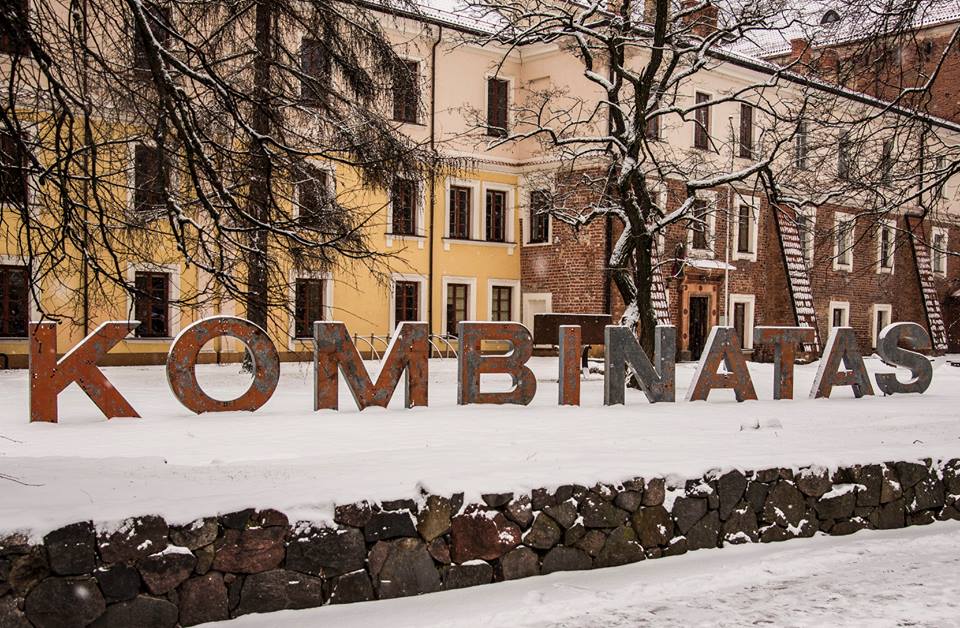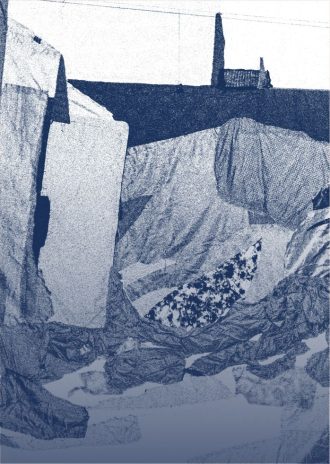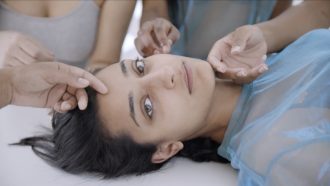
Eglė Grėbliauskaitė, KOMBINATAS, 2015, readymade((According to the author the idea behind the FACTORY (KOMBINATAS) is not merely a criticism of Vilnius Academy of Arts—the implications are much broader and they emphasise the aspects of a factory as such: standardised norms; surveillance; measurements; spoilage; consumption of the convenient; rejection of the inconvenient; relations between the raw materials and the products. We need each other as raw materials for our own forms of production, and we produce what is on demand (or we simply produce raw materials for others). For Lithuanian speakers: Kęstutis Šapoka on the FACTORY.))
Estonian Academy of Art (EAA) is 100 years old. 2014 was the big anniversary year, but also the 10th and the last year of current rectorship as well as the year of an important decision: where the hell EAA is to be located?
In 2010 the old building, where academy was settled since 1917, was demolished. This has overshadowed whole existence of the academy (at least in a subconscious way) of the last 5 years. This political-performative action was meant to speed up the process of building the new house. Results were just opposite: EAA had to pay back € 2,2 million of EU money and sell the luxury lot in the center of Tallinn as well as some other assets following which opinion leaders of economical and political circles expressed doubts of EAA’s capability to manage itself and moreover – whether Estonia needs higher art education at all. Departments of academy moved to different rental spaces around Tallinn and public image of EAA went lower than the lawn.
Of course, concrete is not the main issue of art and education – art comes from mind, not form stones. We still have to admit that Estonians believe in concrete. If an institution does not have a nice house, then it is not a serious institution. KUMU art museum is a good example – even bankers like it, although they don’t have a clue of what is in the inside. So, the house is important for the public image and public image is important to get financial and social capital to exist. The building has a practical function of course above all. It now takes a damn lot of time for students to move from one end of town to another just to take a class. And it is North, it is cold outside, we cannot function properly sitting under the palm tree. Also, it is absolutely necessary to cooperate between disciplines and departments inside the academy – to create the conditions for synergy and new ideas which is impossible without having the departments located close to each other. It is the ground for the identity and self-esteem with it.
How did all of this happen? It started with the new era in all Eastern-Europe. Capitalism, democracy, market economy back then seemed to be solutions for everything. Fast technological development was something new and promising not only here, but all over the world. Illusion of welfare and endless economical growth owerflowed. The best strategy seemed to sail in this bright flow of progress. So, EAA decided to adopt without any criticism all those innovative ideologies. This was the 1990-ties, the yuppie time, hipsters were not born yet.
In 1995 new rector, hyperrealist painter educated as designer, Ando Keskküla was elected and his course was clearly to prioritize design and new media – disciplines that seemed to fit well into market economy. He was also the man who came up with a sly business plan concerning academy’s real estate – suggesting to build new house for the school. The next rector from 2005, textile artist and right-wing politician, Signe Kivi followed this course in more colorful and emotional way. Of course, decisions are made not only by a rector, the council plays a role too. Still, the mentioned leading figures created a confusing public image of the academy by meddling into bohemian scandals on one hand and practicing neo-liberalist rhetoric on the other. Watching from the outside, all of it seemed but one big anecdote.
Neo-liberalism in education is determined mostly by the aim to produce human resources for labor market, in the case of art education – for so called creative industry.
Here is the first contradiction and big question: what is creativity? Is it ability to solve minor problems to adopt better in the system? Is it skill to illustrate already existing processes? Or is it ability to see the big picture, to find unexpected conjunctions there and to re-create the surrounding into a better place? Not to illustrate, but to create? Probably we can call both “creativity”, but I am afraid that without the second, the first would die soon because of simple biological degradation of human brain. Most of population is desperately adopting to labor market, their creativity ends with the false-optimistic job applications. This is adoptive creativity.
For the development of society and humankind we need some generating creativity. We need to preserve those truely creative brain cells in the genetics of human as a species, and those cells are in the heads of artists, philosophers, scientists, explorers. If we teach in schools how to market your creation and forget to teach creativity, then there will be nothing to market in the end. This is just what EAA is trying to do at least such position has been communicated to public for many years. They proudly announce to the media and society when some new pop-up shops are opened or start-ups established. Is this the real role of an art academy – to pretend to be a little diligent business school or incubator?
For many years, fine art was constantly suppressed in EAA. Relevant departments were closed down or joined together to cut the costs. And probably to get rid of those critically-minded and unpredictable fine artists who are constantly disturbing the so called progress. Because no one knows exactly what is the place of a fine artist in labor market and market economy. No one from EU gave orders about them, there were no EU directives, how to handle real artists. For years there were no public announcements about fine art from EAA.
Is it really impossible to integrate contemporary art into society? No, it is not. An ambitiously named independent organization, Estonian Museum of Contemporary Art fulfilled the need for an experimental exhibition space for young artists who are still undergoing art education. Also, Rundum and some more artists-run institutions were established. The information and lessons of survival in the international art world were and are carried out by Center For Contemporary Arts and Estonian Contemporary Art Development Center. So, EAA had a free choice and it chose as it has.
And then, one day I get a press-release roughly saying that design students had a couple of days live model drawing class, they have put the drawings on the wall and this is an exhibition now! Someone has made a couple of drawings in an art academy and it is taken as something miraculous to give out the press-release? Another day, a recently graduated young painter called me up to ask how to put a canvas on the frame. Maybe such skills are ancient history and there is really no need for them in our times. But then again, is there something that they are really skillful in after the studies? Fine artists are forced in school nowadays to read and write a lot. Maybe intellectual capacity has increased now, perhaps they know by heart all contemporary thinkers and are able to write marvelous concepts for their art projects? No, they are not. I still read A4-s on exhibitions where they confess they do not understand the world and create just following their feelings. And they still put the space before the comma, not after. So, what are they studying in the academy anyway?
The answer is Bologna convention. There is no way you can learn something properly in 3 years. EAA as well as the whole education system in Estonia took over the 3+2 system from Bologna convention as soon as possible. There is an old saying: Estonians are obeying stupid Russian rules with German accuracy. Later on it appeared, that the 3-year first level study duration was not an order, but a recommended minimum. To quote the famous Russian politician Chernomyrdin: We wanted the best, but it turned out like always.
Yes, you can get the idea about different disciplines of art in 3 years, but you cannot get deep enough during such a short time. Not always even enough to understand, if you want to continue to the MA. To make good art, it is absolutely necessary to dig deep. But not necessarily into painting or some graphic technique – it could be philosophy, mathematics, music, programming, gardening, skateboarding or something else. 5 or even 4-year course gave young people opportunity to find themselves and go behind the surface. Now, the 3-year system, interrupted by continuous restructuring of the academy which causes sometimes inevitably changing the schedules and departments, and running from one school building to another in EAA’s case, results in confusion and uncertainty of graduates, who don’t know, who they are or want to be.
And now let’s go back to the self-esteem. Yes, the place of fine art in society is complicated. But it does not mean, that we have to accept this confusion sacrificing our main goals and meaning of existence. There are many ways to define art and many approaches to being an artist, there are also different theories for art education, but one thing is considered faulty by them all – being superficial and untruthful toward your own goals.
The creativity that is really needed in society is not the adaptive and illustrative, but real, (re)generative, critical creativity. And this is the only role and only possible self-positioning for artists as well as for the art education. It is crucial that we believe in our significant creative role ourselves first, then everyone else will believe. We cannot trade art for marketing, because there are better marketing managers than we are, but there will be no better artists.
For some reason I believe, or would like to believe, that self-esteem of the artists is being restored in EAA and everything will change for better. As the first sign, the exhibition activity of EAA fine art departments during 2014, after many years, was surprisingly high. Maybe this was because of the anniversary, maybe because there was no house of their own and they needed to make exhibitions in galleries just to perform regular evaluations. Anyway, I enjoyed many contemporary art exhibitions and events of BA, MA and DR level students during last year in galleries of Tallinn and Tartu, as well as EAA’s own new exhibitions spaces opened recently, like ISFAG, Raja and EKA Gallery.
We cross fingers for the new rector, Mart Kalm, who is not a politician with history of public or criminal scandals, but art historian specializing in architecture and seems to have gained the respect of both colleagues and the public.
Finally, the decision to renovate an old factory building in hot-hipster district near the center of Tallinn was made. Hopefully in 2 years the whole family of EAA will be together again.
These practical developments will not answer all questions but at least they create a new, less troubled environment, where these questions could be addressed.
So, happy anniversary, EKA, one more time!
























